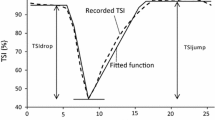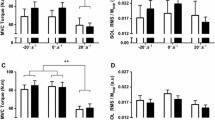Abstract
The objectives of this study were to (1) investigate the modulation of the H reflex immediately after and 24 h after eccentric exercise in the presence of delayed-onset muscle soreness (DOMS) and (2) test the reproducibility of the H reflex in trapezius across days. H reflexes were recorded from the dominant middle trapezius muscle by electrical stimulation of the C3/4 cervical nerve in ten healthy subjects. DOMS was induced by eccentric exercise of the dominant shoulder. H reflexes were obtained in four sessions: “24 h before”, “Pre”, “Post”, and “24 h after” eccentric exercise. Ratios of maximal H reflex and M wave responses (H max/M max) were compared between sessions. In addition, a between session comparison was done for the ratios of H reflex amplitudes (H i_75/M max, and H i_50/M max) obtained from the stimulus intensity needed to obtain 75 and 50 % of H max at “24 h before”. No ratio changes were found when comparing “24 h before” and “Pre” recordings. A decrease in H i_50/M max was found at “Post” (P < 0.05) and decreases in both H i_75/M max and H i_50/M max were observed at “24 h after” (P < 0.05). This study presented evidence that an acceptable day-to-day reproducibility of the H reflex could be obtained with the applied experimental setup. Furthermore, immediately after and 24 h after exercise a stronger stimulus intensity was needed to reach the same magnitude of the H reflex reflecting that the recruitment curve was shifted to the right. This modulation of the stimulus–response relationship could be caused by presynaptic inhibition of Ia afferent fibres’ input to the motoneuron by group III and IV afferents.





Similar content being viewed by others
References
Alexander CM (2007) Altered control of the trapezius muscle in subjects with non-traumatic shoulder instability. Clin Neurophysiol 118:2664–2671
Alexander CM, Harrison PJ (2002) The bilateral reflex control of the trapezius muscle in humans. Exp Brain Res 142:418–424
Armstrong RB (1984) Mechanisms of exercise-induced delayed onset muscular soreness. Med Sci Sports Exerc 16:529–538
Avela J, Kyrolainen H, Komi PV, Rama D (1999) Reduced reflex sensitivity persists several days after long-lasting stretch-shortening cycle exercise. J Appl Physiol 86:1292–1300
Binderup AT, Arendt-Nielsen L, Madeleine P (2010) Pressure pain threshold mapping of the trapezius muscle reveals heterogeneity in the distribution of muscular hyperalgesia after eccentric exercise. Eur J Pain 14:705–712
Brinkworth RSA, Tuncer M, Tucker KJ, Jaberzadeh S, Turker KS (2007) Standardization of H-reflex analyses. J Neurosci Methods 162:1–7
Bulbulian R, Bowles DK (1992) Effect of downhill running on motoneuron pool excitability. J Appl Physiol 73:968–973
Cleak MJ, Eston RG (1992) Delayed onset muscle soreness: mechanisms and management. J Sports Sci 10:325–341
Corcondilas A, Shepherd JT, Koroxeni GT (1964) Effect of brief contraction of forearm muscles on forearm blood flow. J Appl Physiol 19:142–146
Crameri RM, Aagaard P, Qvortrup K, Langberg H, Olesen J, Kjaer M (2007) Myofibre damage in human skeletal muscle: effects of electrical stimulation versus voluntary contraction. J Physiol Lond 583:365–380
Dideriksen JL, Enoka RM, Farina D (2011) Neuromuscular adjustments that constrain submaximal EMG amplitude at task failure of sustained isometric contractions. J Appl Physiol 111:485–494
Dragert K, Zehr EP (2011) Bilateral neuromuscular plasticity from unilateral training of the ankle dorsiflexors. Exp Brain Res 208:217–227
Ebbeling CB, Clarkson PM (1989) Exercise-induced muscle damage and adaptation. Sports Med 7:207–234
Fernandez-Carnero J, Binderup AT, Ge HY, Fernandez-De-Las-Penas C, Arendt-Nielsen L, Madeleine P (2010) Pressure pain sensitivity mapping in experimentally induced lateral epicondylalgia. Med Sci Sports Exerc 42:922–927
Friden J, Sjostrom M, Ekblom B (1983) Myofibrillar damage following intense eccentric exercise in man. Int J Sports Med 4:170–176
Garland SJ, Mccomas AJ (1990) Reflex inhibition of human soleus muscle during fatigue. J Physiol Lond 429:17–27
Ginanneschi F, Dominici F, Milani P, Biasella A, Rossi A, Mazzocchio R (2007) Changes in the recruitment curve of the soleus H-reflex associated with chronic low back pain. Clin Neurophysiol 118:111–118
Gold JE, Punnett L, Katz JN (2006) Pressure pain thresholds and musculoskeletal morbidity in automobile manufacturing workers. Int Arch Occup Environ Health 79:128–134
Hultborn H, Illert M, Nielsen J, Paul A, Ballegaard M, Wiese H (1996) On the mechanism of the post-activation depression of the H-reflex in human subjects. Exp Brain Res 108:450–462
Kawczynski A, Nie H, Jaskolska A, Jaskolski A, Arendt-Nielsen L, Madeleine P (2007) Mechanomyography and electromyography during and after fatiguing shoulder eccentric contractions in males and females. Scand J Med Sci Sports 17:172–179
Klimstra M, Zehr PE (2008) A sigmoid function is the best fit for the ascending limb of the Hoffmann reflex recruitment curve. Exp Brain Res 186:93–105
Kuwabara S, Cappelen-Smith C, Lin CSY, Mogyoros I, Burke D (2002) Effects of voluntary activity on the excitability of motor axons in the peroneal nerve. Muscle Nerve 25:176–184
Le Pera D, Graven-Nielsen T, Valeriani M, Oliviero A, Di Lazzaro V, Tonali PA, Arendt-Nielsen L (2001) Inhibition of motor system excitability at cortical and spinal level by tonic muscle pain. Clin Neurophysiol 112:1633–1641
Lieber RL, Friden J (2002) Morphological and mechanical basis of delayed muscle onset soreness. J Am Acad Orthop Surg 10:67–73
Madeleine P, Lundager B, Voigt M, Arendt-Nielsen L (1998) Sensory manifestations in experimental and work-related chronic neck–shoulder pain. Eur J Pain 2:251–260
Madeleine P, Nie H, Arendt-Nielsen L (2006) Dynamic shoulder dynamometry: a way to develop delay onset muscle soreness in shoulder muscles. J Biomech 39:184–188
Madeleine P, Samani A, Binderup A, Stensdotter AK (2011) Changes in the spatio-temporal organization of the trapezius muscle activity in response to eccentric contractions. Scand J Med Sci Sports 21:277–286
Martin PG, Smith JL, Butler JE, Gandevia SC, Taylor JL (2006) Fatigue-sensitive afferents inhibit extensor but not flexor motoneurons in humans. J Neurosci 26:4796–4802
Mazzocchio R, Scarfò GB, Mariottini A, Muzzi VF, Palma L (2001) Recruitment curve of the soleus H-reflex in chronic back pain and lumbosacral radiculopathy. BMC Musculoskelet Disord 2:4
Misiaszek JE (2003) The H-reflex as a tool in neurophysiology: its limitations and uses in understanding nervous system function. Muscle Nerve 28:144–160
Moore MA, Kukulka CG (1991) Depression of Hoffmann reflexes following voluntary contraction and implications for proprioceptive neuromuscular facilitation therapy. Phys Ther 71:321–329
Mork PJ, Westgaard RH (2006) Low-amplitude trapezius activity in work and leisure and the relation to shoulder and neck pain. J Appl Physiol 100:1142–1149
Nie HL, Kawczynski A, Madeleine P, Arendt-Nielsen L (2005) Delayed onset muscle soreness in neck/shoulder muscles. Eur J Pain 9:653–660
Palmieri RM, Ingersoll CD, Hoffman MA (2004) The Hoffmann reflex: methodologic considerations and applications for use in sports medicine and athletic training research. J Athl Train 39:268–277
Pettorossi VE, la Torre G, Bortolami R, Brunetti O (1999) The role of capsaicin-sensitive muscle afferents in fatigue-induced modulation of the monosynaptic reflex in the rat. Observatory 119:599–607
Pu YM, Tang EY, Yang XD (2008) Trapezius muscle innervation from the spinal accessory nerve and branches of the cervical plexus. Int J Oral Maxillofac Surg 37:567–572
Racinais S, Bringard A, Puchaux K, Noakes TD, Perrey S (2008) Modulation in voluntary neural drive in relation to muscle soreness. Eur J Appl Physiol 102:439–446
Rossi A, Decchi B, Ginanneschi F (1999) Presynaptic excitability changes of group Ia fibres to muscle nociceptive stimulation in humans. Brain Res 818:12–22
Smith L (1961) Acute inflammation: the underlying mechanisms in delayed onset muscle soreness. Med Sci Sports Exerc 23:542–551
Taylor JL, Olsen HB, Sjogaard G, Sogaard K (2009) Voluntary activation of trapezius measured with twitch interpolation. J Electromyogr Kinesiol 19:584–590
Trimble MH, Harp SS (1998) Postexercise potentiation of the H-reflex in humans. Med Sci Sports Exerc 30:933–941
Woods JJ, Furbush F, Biglandritchie B (1987) Evidence for A fatigue-induced reflex inhibition of motoneuron firing rates. J Neurophysiol 58:125–137
Ylinen J, Nykanen M, Kautiainen H, Hakkinen A (2007) Evaluation of repeatability of pressure algometry on the neck muscles for clinical use. Man Ther 12:192–197
Zehr EP (2002) Considerations for use of the Hoffmann reflex in exercise studies. Eur J Appl Physiol 86:455–468
Acknowledgments
The authors are grateful to Dr. A Samani (Aalborg University) for providing a visual feedback interface. The present work was partly supported by a grant from Gigtforeningen and is a part of the “Bionex—The Danish Neck–shoulder” project.
Author information
Authors and Affiliations
Corresponding author
Additional information
Communicated by Dick F. Stegeman.
Rights and permissions
About this article
Cite this article
Vangsgaard, S., Nørgaard, L.T., Flaskager, B.K. et al. Eccentric exercise inhibits the H reflex in the middle part of the trapezius muscle. Eur J Appl Physiol 113, 77–87 (2013). https://doi.org/10.1007/s00421-012-2412-y
Received:
Accepted:
Published:
Issue Date:
DOI: https://doi.org/10.1007/s00421-012-2412-y




